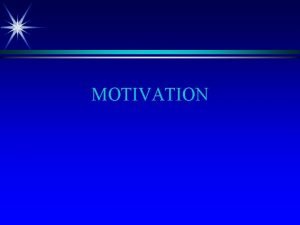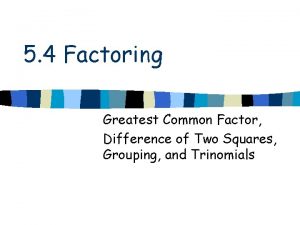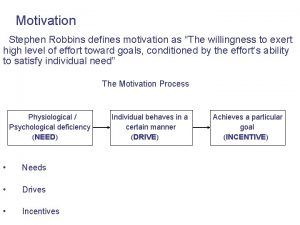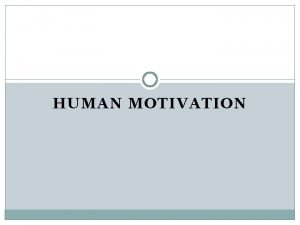MOTIVATION Motivation is driving factor for actions willingness









- Slides: 9

MOTIVATION Motivation is driving factor for actions, willingness, and goals. Motivation is derived from the word motive, or a need that requires satisfaction. These needs wants or desired may be acquired through influence of culture, society, lifestyle or may be generally innate. Motivation is the process that initiates guide and maintains goal-orientated behaviours. It is what causes you to act. Whether it is getting a glass of water to reduce thirst or reading a book to gain knowledge. Whether we are leaving the house to do a simple task (like grocery shopping) or making a major life change like moving to another country, we make these movements for a reason. We do this because these actions allow us to fulfil something that is important to us. Motivation comes from two places: • Intrinsic motivation: This is when motivation comes from "internal" factors to meet personal needs. We do things we do because we enjoy them, not because we have to. Intrinsic means internal or inside of yourself; when you are intrinsically motivated, you enjoy an interest, a course of study or skill development solely for the fulfilment of education and having fun • Extrinsic motivation: This is when motivation comes from "external" factors that are given or controlled by others. Salary or praise are good examples. This type of motivation is everywhere and frequently used within society.

What Motivates You There is no such thing as an unmotivated person. Everyone is motivated to do something. Therefore, everyone is motivated. You cannot motivate someone else to work harder. You can find what is important to them — what motivates them — and then find ways to make sure they get more of that as a reward for high-level performance. Money and Rewards, Desire to be the Best, Helping Others, Recognition, Power, Passion. Providing yourself with a sense of security : Being in a supportive environment, surrounding yourself with your basic needs – physiological – food, water and sleep. Economic and physical security – safety. Love and belonging – in a loving family and social group. Clear communication: Being transparent providing clarity. Every relationship including work relationships is built on trust. Transparency is one of the best ways to encourage an atmosphere of trust. A team that trusts will be more motivated and engaged with their work. Make your goals attainable: Challenge yourself with high expectations as long as you believe those goals to be within your reach, don’t be afraid to push yourself.

5 Factors key to creating motivation in employees: Reward and recognition come hand in hand. Recognition for good work as a limited shelf life. Employees begin to lose motivation if they are not regularly recognised for their efforts and rewarded. Development is very important for motivating employees. Development makes an employee self-dependent and allows them to contribute more effectively to the workplace and enhance their input to your business. Leadership A good leader has the knowledge of what truly inspired loyal and motivated humans to perform at a high level. It is important that a good leader has reasonable expectations, gives credit where credit is due and appreciates their staff. Work life balance Providing a good work life balance nurtures employee. Motivated employees are less likely to take sick days, leave the organisation and will be prepared to work longer hours. Work environment Motivated employees thrive in a positive work environment: physical and non-physical: Working in open office space environment that stimulates the sense, which also incorporates the outside green spaces Regarding the intangible environment, motivated employees value engagement and communication – regular feedback and daily challenges.

Maslow's Hierarchy of Needs Maslow first introduced his concept of a hierarchy of needs in his 1943 paper "A Theory of Human Motivation" and his subsequent book Motivation and Personality. This hierarchy suggests that people are motivated to fulfil basic needs before moving on to other, more advanced needs. Maslow was much more interested in learning about what makes people happy and the things that they do to achieve that aim. As a humanist, Maslow believed that people have an inborn desire to be self-actualized, that is, to be all they can be. In order to achieve these ultimate goals, however, a number of more basic needs must be met such as the need for food, safety, love, and self-esteem. 1 There are five different levels of Maslow’s hierarchy of needs. Overview of Needs Maslow's hierarchy is most often displayed as a pyramid. The lowest levels of the pyramid are made up of the most basic needs, while the most complex needs are at the top of the pyramid. Needs at the bottom of the pyramid are basic physical requirements including the need for food, water, sleep, and warmth. Once these lower-level needs have been met, people can move on to the next level of needs, which are for safety and security. As people progress up the pyramid, needs become increasingly psychological and social. Soon, the need for love, friendship, and intimacy becomes important. Further up the pyramid, the need for personal esteem and feelings of accomplishment take priority. Maslow emphasized the importance of self-actualization, which is a process of growing and developing as a person in order to achieve individual potential.

Herzberg’s Theory Herzberg's motivation theory is one of the content theories of motivation. These attempt to explain the factors that motivate individuals through identifying and satisfying their individual needs, desires and the aims pursued to satisfy these desires. This theory of motivation is known as a two-factor content theory. Two-factor theory distinguishes between: Herzberg had close links with Maslow and believed in a two-factor theory of motivation. He argued that there were certain factors that a business could introduce that would directly motivate employees to work harder motivators. However, there were also factors that would de-motivate an employee if not present but would not in themselves actually motivate employees to work harder hygiene factors. Herzberg’s Motivating and Hygiene Factors Motivating Factors: Hygiene Factors: Achievement Company policy Recognition Supervision Work itself Working conditions Responsibility Interpersonal relationship at work Advancement Salary & benefits Growth. Job security.


Maslow’s Hierarchy of Needs How does this currently relate to you? Esteem needs - which Maslow classified into two categories: (i) esteem for oneself (dignity, achievement, mastery, independence) and (ii) the desire for reputation or respect from others (e. g. , status, prestige). My recognition as a level 3 supervisory apprentice at West Ham Park and the additional recognition of the City of London Corporation to provide me with a constant presence of a trainee to build a working relationship with and, furthermore, provide me with consistency, continuity and confidence to roll-out my knowledge and document evidence was not met. This lack of responsibility on my employer’s part, made me feel worthless, underappreciated and demotivated. Cognitive needs - knowledge and understanding, curiosity, exploration, need for meaning and predictability. I felt I was used as an ‘agency worker’ during my first year as a level 3 supervisory apprentice. No real interest in my situation was provided; no structure of training sessions with level 2 apprentices or volunteers. Regular check-ins for improvement on my curriculum should have been instigated to provide what was needed for me to achieve the optimum knowledge and understanding. Self-actualization needs - realizing personal potential, self-fulfillment, seeking personal growth and peak experiences. I completed reviews and questionnaires for the Corporation’s representatives, raising ‘red-flags’ and was basically ignored. I had to take steps to make everyone realise what was not-happening, for something to shift and a constructive schedule to be put in place for goals to be met and achieved.

Maslow’s Hierarchy of Needs How does it relate to motivation? The basic idea of Maslow’s Hierarchy of Needs is that our needs are constantly changing. As one need is met, we desire other needs. • Will the raise we received 3 years ago motivate us for the next 10 years? • Will the challenging job we began 5 years ago have the same effect on us today? • Will the performance award we received last year completely satisfy our need for recognition for the rest of our lives? The answers to all these questions is usually, no. Finding ways to increase motivation is crucial because it allows us to change behaviour, develop competencies, be creative, set goals, grow interests, make plans, develop talents, and boost engagement. While dated, Maslow's theory is useful for both personal development and workplace growth. By identifying what humans need and what drives and motivates people, employers and employees can develop mutually beneficial relationships and positive environments conducive to work. Peoples needs change with time. To promote workplace motivation, we need to continually adapt to these changing needs.

QUESTIONS How can Maslow’s theory be used to motivate employees? How would you relate Maslow’s hierarchy of needs in your life? Why do you feel Maslow’s theory criticized? What does Herzberg theory say about motivation? What are the limitations of the Herzberg theory?
















